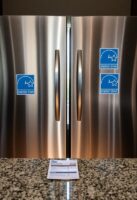You can access up to $11,200 in ENERGY STAR home rebates through a combination of federal, state, and local programs. Federal tax credits cover 30% of costs up to $3,200 annually, while state HOMES programs offer up to $8,000 for qualifying households. Your local utility company may provide supplementary incentives for specific upgrades. Start by scheduling a professional energy audit and gathering documentation to enhance your available benefits. Understanding the complete rebate landscape will help reveal your home’s full savings potential.
Key Takeaways
- Visit ENERGY STAR’s website and enter your zip code to search available rebates and incentives in your area.
- Contact your local utility company directly to inquire about specific ENERGY STAR rebate programs they offer.
- Schedule a professional home energy audit to identify eligible upgrades that qualify for maximum rebate potential.
- Check state-level programs, which can offer up to $8,000 in rebates for qualifying ENERGY STAR home improvements.
- Compile required documentation including purchase receipts, manufacturer specifications, and energy audit reports before applying.
Federal Tax Credits for Home Energy Upgrades
When planning energy-efficient home improvements, you’ll want to understand the substantial federal tax credits available through 2032. You can claim up to $3,200 annually for qualifying upgrades, with the government covering 30% of your costs.
These tax benefits include up to $2,000 for heat pumps and $1,200 for insulation, windows, and doors.
To enhance your energy savings, consider spreading improvements across multiple tax years. The credit applies to your principal residence, and you’ll need to file Form 5695 with your tax return.
Available State-Level Rebate Programs
Through the Home Efficiency Rebates (HOMES) Program, you’ll find substantial financial incentives for extensive energy improvements that achieve at least 20% whole-house energy savings.
Several state rebate programs have already launched in Georgia, Michigan, North Carolina, D.C., and Wisconsin, with more states set to implement their energy efficiency initiatives throughout 2025.
You can qualify for up to $4,000 in rebates for standard households, or $8,000 if you’re in a low-income bracket.
Your state’s program will require pre-qualification, energy assessments, and certified contractor installations.
Check your local program requirements, as states customize implementation to meet regional needs and priorities.
How to Qualify for Local Utility Company Incentives
To qualify for local utility company incentives, you’ll need to meet specific eligibility requirements and follow a structured application process.
Check your local eligibility by verifying income thresholds and property ownership status with your utility provider. Most programs require you to own your home or have a long-term lease.
For successful application tips, start by scheduling a home energy audit if required.
Submit all necessary documentation, including proof of purchase and manufacturer specifications. You’ll need to use certified contractors for installations and meet specific energy-efficiency criteria.
Remember to obtain pre-approval before beginning any upgrades and complete them within the program’s designated timeframe.
Maximizing Your ENERGY STAR Home Upgrade Benefits
By implementing a strategic approach to ENERGY STAR upgrades, you’ll optimize both energy savings and available rebates for your home improvements.
Start with a professional energy audit to establish your home’s baseline performance and identify priority upgrades.
Consider bundling multiple improvements to enhance rebate potential and achieve synergistic benefits.
Time your upgrade strategies around natural equipment replacement cycles to optimize investment timing and technological advantages.
Install smart monitoring systems to track performance and maintain efficiency.
Combine available financing options, including utility programs and PACE financing, to make larger projects more affordable while ensuring long-term energy management success.
Step-by-Step Guide to Claiming Your Energy Efficiency Rebates
When claiming energy efficiency rebates, a systematic approach guarantees you’ll optimize your returns while avoiding common submission pitfalls.
Research your rebate eligibility through ENERGY STAR’s website, state programs, and utility companies to identify all available opportunities. Gather thorough documentation before starting any application process.
- Compile crucial paperwork: purchase receipts, manufacturer certifications, energy audit reports, and before/after utility bills.
- Complete all application forms accurately, ensuring you’ve attached required supporting materials.
- Submit your package through the specified channel (online, mail, or in-person) and track your application status regularly.
Remember to maintain copies of all submitted documents for your records.
Smart Ways to Stack Multiple Rebate Programs
Maximizing your energy efficiency savings requires a strategic approach to combining multiple rebate programs.
You’ll want to stack federal IRA rebates with state and utility incentives while coordinating separate upgrades under different programs. For instance, you can combine HOMES rebates with HEEHR funds when making distinct improvements, and pair 25C tax credits with either program.
Your rebate strategies should align with income-based opportunities. If you’re below 200% of the poverty line, you’re eligible for maximum coverage.
Work with local energy offices to integrate your upgrades with existing assessment programs and utility incentives for ideal program coordination.
Key Deadlines and Documentation Requirements
To secure your Energy Star rebates, you’ll need to carefully track multiple deadlines and compile specific documentation. Most HEEHRA rebates launch in initial 2025, while the Energy Efficient Home Improvement Credit extends through 2032. State programs have varying application deadlines, with some starting fall 2024.
Required documentation includes purchase receipts, installation records, Energy Star labels, and current utility bills.
Applications must be complete with proof of permit closure for furnace installations.
Submit early, as funds are distributed first-come, first-served and may deplete before deadlines.
Remember to verify local program deadlines and documentation requirements, as they vary by location and rebate type.
Conclusion
Take advantage of multiple ENERGY STAR rebate opportunities by layering federal tax credits, state programs, and local utility incentives. You’ll need to maintain detailed documentation, including receipts, certification paperwork, and installation records. Track submission deadlines carefully and verify eligibility requirements before making purchases. Submit your claims promptly through the appropriate channels, whether online portals or mail-in forms, to guarantee you don’t miss out on valuable energy efficiency savings.



